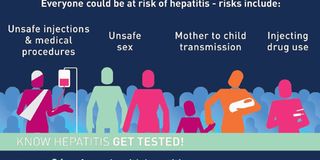Hepatitis B risk factors: Needle injuries, sex, birth and more

An infographic illustrating the risk factors for hepatitis B. PHOTO | WORLD HEALTH ORGANISATION
The untold story of a silent killer, Hepatitis, shows that the disease is known for killing more people than HIV/AIDS. Hepatitis is caused by a viral infection; and because of that it has more striking force than that of HIV. It attacks the liver and can cause both acute and chronic disease.
A study by the Global Burden of Disease shows deaths caused by viral hepatitis have surpassed all chronic infectious diseases including HIV/AIDS, malaria and tuberculosis.
Speaking to Your Health, Dr Zacharia Kabona, says one-third of the world’s population has been affected with 2 people dying each minute from hepatitis - a viral infection that attacks the liver. Dr Kabona says unlike ebola which is mostly concentrated in Central and some parts of West Africa, hepatitis has spread almost in every region of the world.
“Any person can be infected with the virus that causes hepatitis as the disease is transmitted through viral micro organisms, which are found in three concentrations in body fluids,” Dr Kabona explaining to Mwananchi Communications Limited workers during a morning health-talk session on hepatitis B, which was conducted and organised by a team of specialists from AAR Health Care.
“One can be affected through blood, serum, and wound exudates. The second, more moderate means of infection is where by one can be affected through semen, vaginal fluid and saliva and lastly one can be affected hrough urine, feaces, sweat and tears though these pose a lower risk,” he says.
Who is at risk?
Dr Kabona says different people are at the risk of getting the infection. One of the risk factors is through needlestick injury used by infected drug abusers or during infected blood transfusion and hemodialysis.
“For example in the process of cleaning blood a person with hepatitis B (dialysis patient) his/her blood passes from his/her body to the dialysis machine and when another person without hepatitis B virus use the same machine to clean his/her blood he will be transmitted (hemodialysis),” he says.
Another group who at great risk in getting the disease are health workers due to fact that most of the time they touch blood so it’s easy to be infected.
Therefore it is important for health workers to be very careful in performing their daily duties.
Sexual intercourse with an infected partner is another mode of transmission. “Sexual transmission of hepatitis B may occur, particularly in unvaccinated men who have sex with men and heterosexual persons with multiple sex partners,” he says.
The virus can also unfortunately be transmitted from mother to child during birth. Dr Kabona is therefore urging women to visit the antenatal clinic as soon as they discover they are pregnant.
World Health Organisation (WHO) recommends that women start antenatal care at a gestational age of less than 12 weeks – this is referred to as ‘early antenatal care’.
Early antenatal care is a critical opportunity for health providers to deliver care and support, and to give information, to pregnant women in the first trimester of pregnancy, including hepatitis status.
“If they start clinic early they will be vaccinated,” he says.
According to Dr Kabona, hepatitis B virus can survive outside the body for at least 7 days and the virus can still cause infection if it enters the body of a person who is not protected by the vaccine.
Symptoms
Speaking on the symptoms, Dr Kabona says most people with hepatitis B virus (HBV) don’t have any symptoms until is too late. He says patients don’t experience any symptoms when newly infected although the symptoms begin from 60-159 days after exposure to HBV.
“The symptoms and signs include flu, fatigue, abdominal pain, loss of appetite, nausea, vomiting, joint pain and jaundice (yellowing of the skin and eyes). Patients can have either an acute symptomatic disease or an asymptomatic disease. One in four adults with chronic HBV will die from liver cancer or liver cirrhosis,” he says.
According to the WHO, an estimated 257 million people, globally, are living with the hepatitis B virus. There is no specific treatment for acute hepatitis B although chronic hepatitis B infection can be treated with medicines, including oral antiviral agents to help slow the progression of cirrhosis and reduce occurrence of liver cancer.
“All people should go for vaccination while the WHO recommends all infants receive the first dose of the hepatitis B vaccine within 24 hours of birth (often called the “birth dose”) and to then complete the vaccine series at 2 and 6 months.




